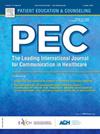Patient assertiveness and visit outcome in primary care: An observational study
IF 2.9
2区 医学
Q2 PUBLIC, ENVIRONMENTAL & OCCUPATIONAL HEALTH
引用次数: 0
Abstract
Objectives
In recent years, there has been growing attention to patient assertiveness in interactions with healthcare providers. This observational study examines patient assertiveness and visit outcomes during routine general practitioner (GP) visits in the Netherlands.
Methods
Video-recorded visits (n = 189) were analysed using a systematic coding protocol.
Results
Patients expressed a median of 2 assertive behaviours per visit (IQR, 1–3), with the majority being self-initiated. Around one in eight patients did not express any assertive behaviour during the visit. Assertiveness was most commonly demonstrated through introducing new topics, with disagreements and direct requests being less frequent. Patients whose visit outcome involved treatment or a referral had behaved assertively more often than those receiving advice or reassurance.
Conclusions
This study could serve as a starting point for assessing patient assertiveness in primary care.
Implications
These findings suggest that patient assertiveness influences the visit outcome, highlighting the need for future research to assess whether this leads to variations in care and care outcomes.
初级保健患者自信与访问结果:一项观察性研究
目的 近年来,患者在与医疗服务提供者的互动中表现出的自信越来越受到关注。本观察性研究探讨了荷兰全科医生(GP)常规就诊过程中患者的自信行为和就诊结果。方法采用系统编码协议分析了视频记录的就诊情况(n = 189)。大约八分之一的患者在就诊期间没有表达过任何自信行为。自信行为最常见的表现形式是引入新话题,而提出不同意见和直接要求的情况较少。与接受建议或安抚的患者相比,就诊结果涉及治疗或转诊的患者更常表现出自信。
本文章由计算机程序翻译,如有差异,请以英文原文为准。
求助全文
约1分钟内获得全文
求助全文
来源期刊

Patient Education and Counseling
医学-公共卫生、环境卫生与职业卫生
CiteScore
5.60
自引率
11.40%
发文量
384
审稿时长
46 days
期刊介绍:
Patient Education and Counseling is an interdisciplinary, international journal for patient education and health promotion researchers, managers and clinicians. The journal seeks to explore and elucidate the educational, counseling and communication models in health care. Its aim is to provide a forum for fundamental as well as applied research, and to promote the study of organizational issues involved with the delivery of patient education, counseling, health promotion services and training models in improving communication between providers and patients.
 求助内容:
求助内容: 应助结果提醒方式:
应助结果提醒方式:


